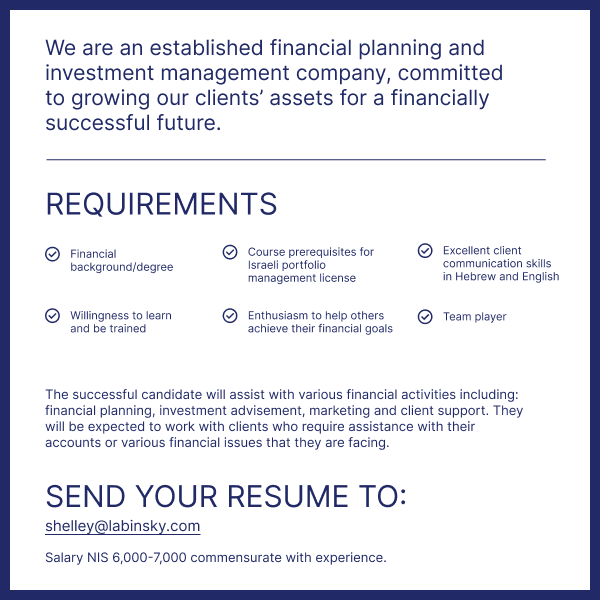For many years near zero interest rates dominated most western economies, with savers earning little or nothing on deposits in their financial institutions. However, the increased interest rates which are causing havoc on large parts of the economy, are returning the possibility of earning something for your cash on deposit. Cashing in on the higher interest rates being offered by banks sounds very appealing to many people, especially those who were too scared to invest their money in the stock or bond markets over the last decade (not to speak of venturing into more speculative asset classes like crypto currencies).
Over the past few weeks several people have approached me saying they think now is the perfect time to lock up their money for a couple of years and benefit from those increased rates. After all, in Israel for the past seven and half years when interest rates were hovering around 0% (0.1% to be precise), investing in the banks’ saving vehicles was not an appealing option. Tying your funds up for virtually no return was incredibly unattractive. However, with interest rates from the bank of Israel currently at 3.75% (and the bank prime rates at 5.25%) after a series of 7 increases over 10 months, everything looks very different. Interest rates are now the highest they have been since 2008, so why not take advantage of the banks’ generous offerings?
As a portfolio manager rather than a banker I will acknowledge that I am more attuned to the benefits of the financial markets. However, I will also state here that I am a portfolio manager precisely because I feel that investing correctly in a diversified manner with both bond and stock exposure, is the best way for most smaller investors to maximize their long term savings.
There is no denying that we are in a bear market, and no-one can say for certainty how long it will last. The longest ever bear market (according to certain formulas) lasted approximately 20 months in 1973/74, while the shortest bear market lasted 33 days in 2020 when Covid-19 impacted the world. The 2020 instance was not only incredibly short in duration but within just over a month the markets began a recovery of almost two years of incredible growth, much beyond the pre-fall levels. Our current market fall began in January 2022, which means we have been in this bear market for just over a year. (The S&P 500 was officially declared a bear market only in June 2022 when the market dropped 20%.)
The crucial element that everyone needs to remember is that often the markets are a leading indicator of future activity in the economy. Investors and traders try to anticipate the future, and trade based on expectations rather than actual current facts. Stock prices thus reflect what investors think a company or an economy/industry will perform in the future. When we look at the lower stock prices in the current market, we need to change the mindset that tells us the economy is bad now, so prices are expected to drop even further. Replace that train of thought with the one that says, the current prices are a reflection of past events and expectations. But future market prices may rally even though the economy itself may well be several months or even years away from recovery. In other words, we will not necessarily be in a bear market going forward into a projected recession. Most times the bear market ended long before economic activity, which is only released with major lags, actually started to improve.
It’s all in the timing and unfortunately, it is very difficult to time the market, which is why the high majority of investors fail to time entries and exits from the market. Although we don’t know precisely when the market will recover, it will likely continue to grow as it has for decades and more. In order to benefit from future stock market gains, we need to invest during times of uncertainty, rather than wait until after we see the economic recovery well in force. Those who invest while the prices are on an upward swing have often missed the bulk of the profit.
Investing must be focused on your goals and for most people, it needs to have a long term focus. The same way that your pension funds are invested over many months of work contributions and stay invested for decades, other investments also need long time horizons to see success.
If you are contemplating investing via the banks’ savings plans, do your homework first. Look at your financial plan and see exactly what kind of sums you are thinking of investing and for what length of time. Then do your research and decide what type of investing will offer you the long term financial success that you seek. If you are unable to do the research yourself, contact a professional for advice. Behatzlacha!
Baruch Labinsky is the founder of Labinsky Financial, specialists in budgeting, retirement planning, investment management and pre- and post-Aliyah financial planning. Licensed by the Israel Securities Authority as a portfolio manager, Baruch specializes in working with olim who are looking to grow their wealth successfully, and is the author of the olim’s ‘bible’ “A Financial Guide to Aliyah and Life in Israel”. Contact us on 02 9910029 or email info@labinsky.com.
Visit our free online Aliyah resource www.financialguidetoaliyah.com










Leave a Reply